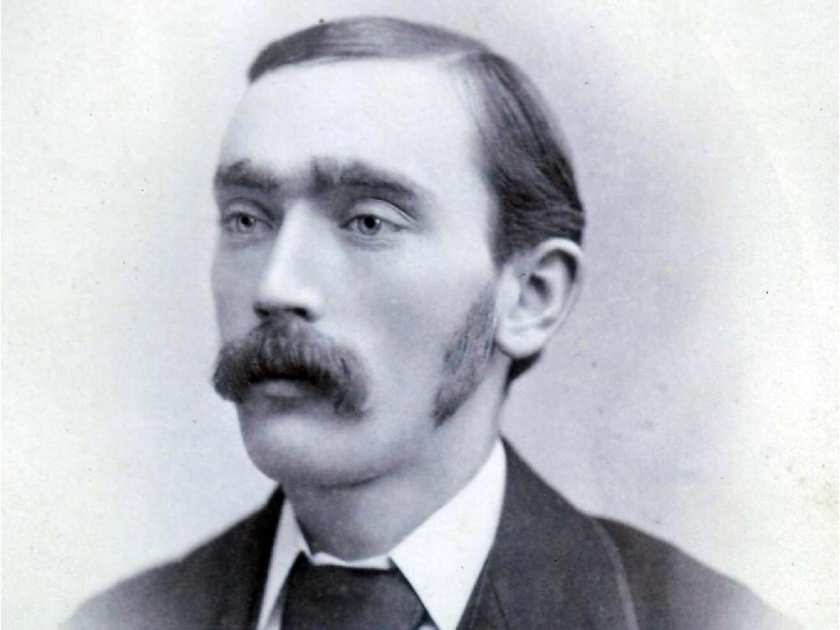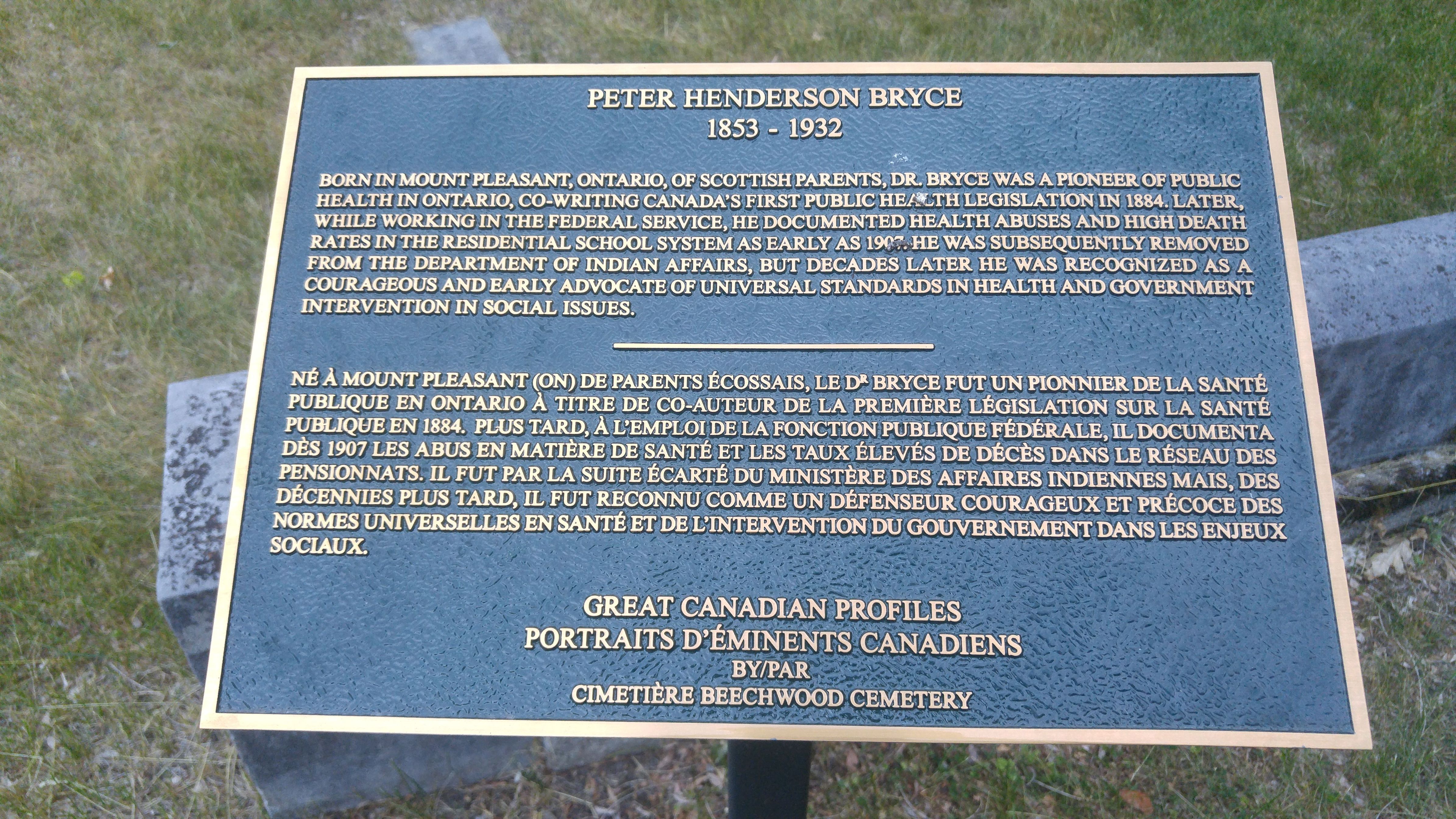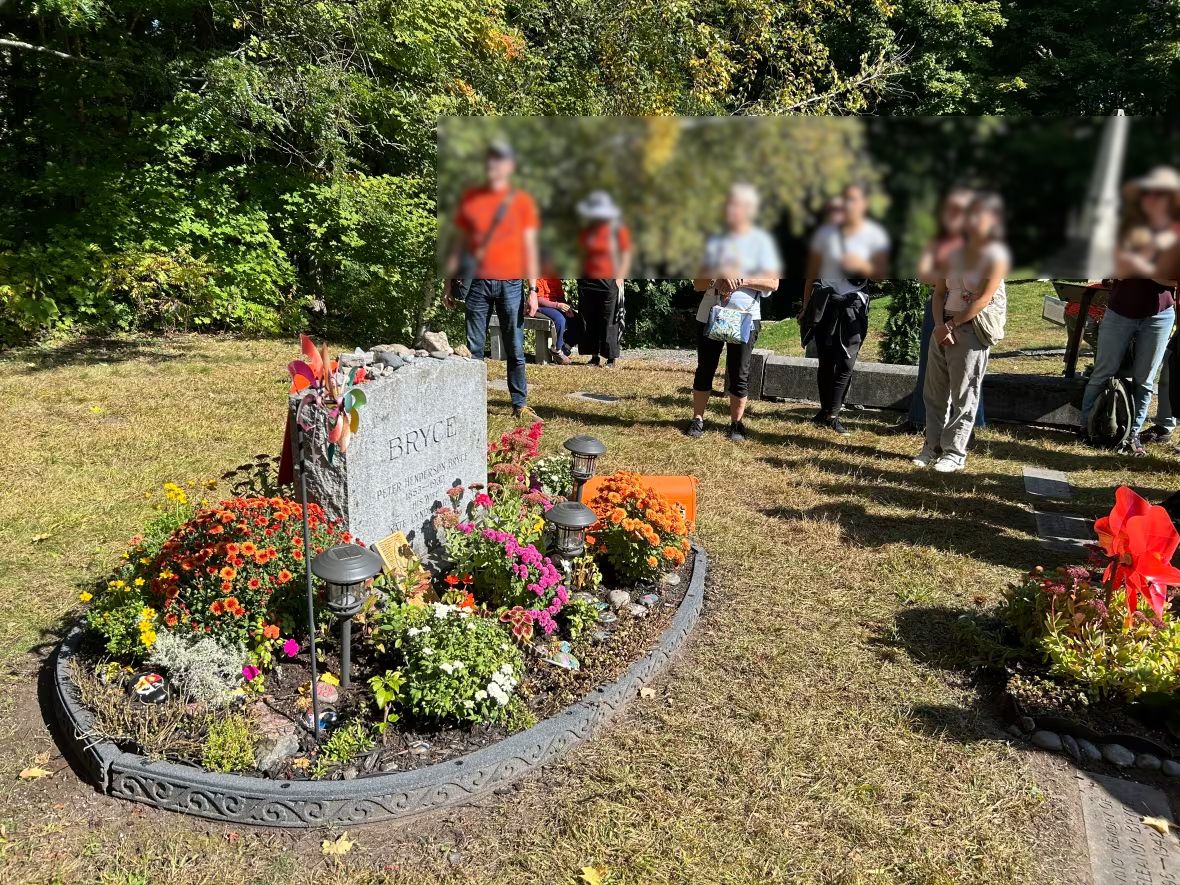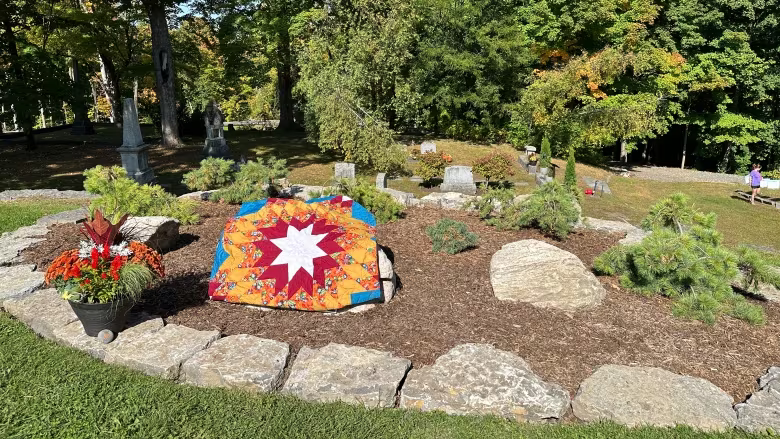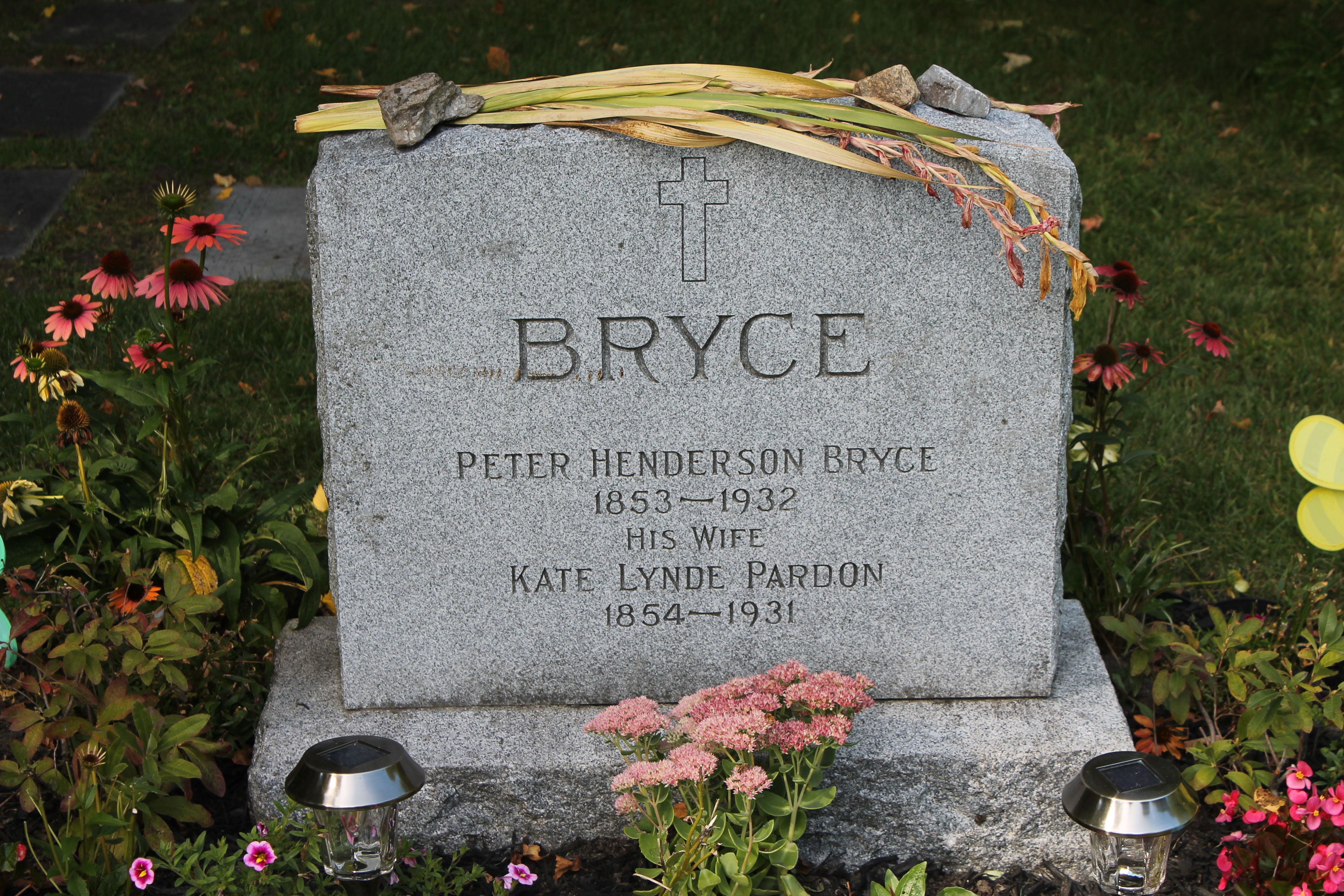Crusader for the health of Canada's indigenous youth
Great Canadian
The story of Dr. Peter Henderson Bryce is about the strength of people who make a choice to stand up for what is right for children in a peaceful and respectful way, even when faced with doubt and criticism.
Recognized as a pioneer in the field of public health in his home province of Ontario and for all of Canada, Dr Bryce is honoured today as a tenacious and courageous advocate / crusader for the health of Canada's indigenous youth. They had been forced into unsanitary and purposely oppressive conditions in the system of Indian Residential Schools that operated, in one form or another, nationwide, from pre-Confederation times (i.e., 1828) until much too recently (1996); a system now recognized as "cultural genocide" for its efforts to "remove the Indian from the child".
His most well-known act was the preparation of the "Report on the Indian Schools of Manitoba and the Northwest Territories"; commonly known as "The Bryce Report". This exposé of the conditions in the schools, prepared and submitted in 1907 and which made clear that the federal government was directly responsible for those conditions, was never released by the body that hired him: the Canadian Government's Indian Affairs Department.
In it, he condemned the treatment of the indigenous youth at the hands of the Government of Canada. As an example, it cited a mortality rate of 14% to 24% in the schools and an infant mortality rate on the reserves of the day of 42%, due, at least in part, to the fact that sick children (most often suffering from tuberculosis) were being sent home to die. He also called out the unreliability of the official statistics due to the defective prevailing reporting practices.
As part of his ongoing work in the department, he advocated for the establishment of temporary hospitals near or on the reserves as a way to address the very high rates of tuberculosis deaths there.
Prior to this engagement, after studying in, among other locations, Toronto and Paris, he had lectured in science and applied chemistry, served as the first secretary of the Ontario Board of Health (from 1882 to 1904) and was then appointed Chief Medical Officer of the federal Department of Immigration. Following many years of conflict with other influential civil servants of the day in his role as a "whistleblower", in 1921, he was forced to retire from the Civil Service, subsequently losing an appeal of that action.
He then went on to self-publish his report in 1922 under the title "The Story of a National Crime: Being a Record of the Health Conditions of the Indians of Canada from 1904 to 1921."
The Truth and Reconciliation Commission of Canada's Final Report on Canada's Residential schools includes a section about him, the contributions of his 1907 report and the recommendations that he put forward to the federal government (2015, p. 401-407).
Also of note:
He was an active member of the Canadian Association for the Prevention of Tuberculosis.
In 1900, he became the first Canadian President of the American Public Health Association.
His legacy is honoured by the (First Nations Child and Family) Caring Society of Canada, which confers a bi-annual honour in his name for "the work of children and youth who demonstrate commitment to Indigenous children's health, safety, and wellbeing"
-- about the award: https://fncaringsociety.com/ph-bryce-award
-- about Dr Bryce: https://fncaringsociety.com/people-history
-- the Caring Society's information sheet about the man: https://fncaringsociety.com/sites/default/files/dr._peter_henderson_bryce_information_sheet.pdf
His professional story is told in further detail:
- In an article in The Canadian Encyclopedia
-- https://www.thecanadianencyclopedia.ca/en/article/peter-henderson-bryce
- in a CBC documentary entitled "Finding Heart" which tells the story of how he, as a medical inspector for the Department of Indian Affairs, made a direct link between the conditions in residential schools and a deadly tuberculosis epidemic in First Nations children in 1907
-- https://www.cbc.ca/player/play/2686200716
- in a Wikipedia article
-- https://en.wikipedia.org/wiki/Peter_Bryce
- as a part of the "Reconciling History Tour" operated by the Beechwood Cemetery (designated as "the National Cemetery of Canada"), where his place in history is recognized with a plaque naming him as a "Great Canadian"
-- https://beechwoodottawa.ca/en/blog/reconciling-history-tour
- wherein his story is highlighted among others as one that has often been told from only one convenient viewpoint when they are, in reality, much more complex and should be seen from other viewpoints, as well, in order to appreciate the full impact of their lives
-- https://www.cbc.ca/news/canada/ottawa/beechwood-cemetery-ottawa-reconciling-history-tour-1.6060442
Thank you for speaking up:
- "Dear Dr. Bryce: Letters to late residential school whistleblower express gratitude, pledge action"
For someone who died nearly 90 years ago, Dr. Peter Bryce sure gets a lot of mail.
Bryce was the chief health inspector for the Department of Indian Affairs who, in the early 20th century, tried to alert the nation to the atrocious conditions in residential schools — where abuse, malnutrition and especially tuberculosis were taking a deadly toll on the children forced to attend the institutions.
His warnings were largely ignored, and he was branded a troublemaker and pushed into retirement from the public service. In 1922, Bryce published his own pamphlet about the schools titled The Story of a National Crime. He died a decade later.
https://www.cbc.ca/news/canada/ottawa/dr-bryce-letters-residential-school-whistleblower-1.6190973
Video included in that report highlighting the mailbox set up at his memorial:
https://www.cbc.ca/news/canada/ottawa/residents-leave-letters-of-hope-at-grave-of-residential-school-whistleblower-1.6191479
- "Doctor who blew whistle on atrocities of residential schools honoured in Ottawa"
One hundred years ago, the former chief medical health inspector of what was then known as Canada's Indian Affairs department walked through the doors of a publishing house in Ottawa.
He carried a manuscript called A National Crime. It was published in 1922 detailing the appalling and deadly health conditions in government-funded residential schools.
On the second National Day for Truth and Reconciliation, Dr. Peter Bryce is being honoured with a plaque in front of the very same building of the publishing house that released his work, James Hope & Sons, at 61 Sparks St.
https://www.cbc.ca/news/politics/peter-bryce-plaque-ottawa-national-truth-reconciliation-1.6599608
- "Poignant memorial to residential school children unveiled at Beechwood Cemetery" (CBC, 2023/09/30)
A new monument at Ottawa's Beechwood Cemetery now stands as a sobering memorial to the Indigenous children who never made it back to their families after attending Canada's oppressive residential schools.
It's called the Children's Sacred Forest and consists of a circle of rocks, about 10 metres wide, at the crest of a small hill overlooking the headstone of Dr. Peter Bryce.
Bryce was the former chief medical health inspector of what was then known as Canada's Indian Affairs Department who blew the whistle on the horrors of the residential school system.
https://www.cbc.ca/news/canada/ottawa/ottawa-children-s-sacred-forest-unveiling-beechwood-cemetery-nation-day-truth-reconciliation-2023-1.6983787
------
Personal and family details
Parents: George and Catherine Bryce
Married Kate Lynde Pardon, daughter of William and Madeline Pardon, on 17 Aug 1882 in Whitby, Ontario, Canada. Died at sea on his way to the then British West Indies.
Their children not connected here [2023/09]:
Jean Alexandra Bryce born 11 Dec 1893 in York Township, Ontario married Cuthbert Cooper Robinson who was born in Japan, son of Rev. John Cooper Robinson and Betsy Poynton, on 28 Aug 1920 at St. Andrew's Church, Ottawa, Ontario, Canada
Crusader for the health of Canada's indigenous youth
Great Canadian
The story of Dr. Peter Henderson Bryce is about the strength of people who make a choice to stand up for what is right for children in a peaceful and respectful way, even when faced with doubt and criticism.
Recognized as a pioneer in the field of public health in his home province of Ontario and for all of Canada, Dr Bryce is honoured today as a tenacious and courageous advocate / crusader for the health of Canada's indigenous youth. They had been forced into unsanitary and purposely oppressive conditions in the system of Indian Residential Schools that operated, in one form or another, nationwide, from pre-Confederation times (i.e., 1828) until much too recently (1996); a system now recognized as "cultural genocide" for its efforts to "remove the Indian from the child".
His most well-known act was the preparation of the "Report on the Indian Schools of Manitoba and the Northwest Territories"; commonly known as "The Bryce Report". This exposé of the conditions in the schools, prepared and submitted in 1907 and which made clear that the federal government was directly responsible for those conditions, was never released by the body that hired him: the Canadian Government's Indian Affairs Department.
In it, he condemned the treatment of the indigenous youth at the hands of the Government of Canada. As an example, it cited a mortality rate of 14% to 24% in the schools and an infant mortality rate on the reserves of the day of 42%, due, at least in part, to the fact that sick children (most often suffering from tuberculosis) were being sent home to die. He also called out the unreliability of the official statistics due to the defective prevailing reporting practices.
As part of his ongoing work in the department, he advocated for the establishment of temporary hospitals near or on the reserves as a way to address the very high rates of tuberculosis deaths there.
Prior to this engagement, after studying in, among other locations, Toronto and Paris, he had lectured in science and applied chemistry, served as the first secretary of the Ontario Board of Health (from 1882 to 1904) and was then appointed Chief Medical Officer of the federal Department of Immigration. Following many years of conflict with other influential civil servants of the day in his role as a "whistleblower", in 1921, he was forced to retire from the Civil Service, subsequently losing an appeal of that action.
He then went on to self-publish his report in 1922 under the title "The Story of a National Crime: Being a Record of the Health Conditions of the Indians of Canada from 1904 to 1921."
The Truth and Reconciliation Commission of Canada's Final Report on Canada's Residential schools includes a section about him, the contributions of his 1907 report and the recommendations that he put forward to the federal government (2015, p. 401-407).
Also of note:
He was an active member of the Canadian Association for the Prevention of Tuberculosis.
In 1900, he became the first Canadian President of the American Public Health Association.
His legacy is honoured by the (First Nations Child and Family) Caring Society of Canada, which confers a bi-annual honour in his name for "the work of children and youth who demonstrate commitment to Indigenous children's health, safety, and wellbeing"
-- about the award: https://fncaringsociety.com/ph-bryce-award
-- about Dr Bryce: https://fncaringsociety.com/people-history
-- the Caring Society's information sheet about the man: https://fncaringsociety.com/sites/default/files/dr._peter_henderson_bryce_information_sheet.pdf
His professional story is told in further detail:
- In an article in The Canadian Encyclopedia
-- https://www.thecanadianencyclopedia.ca/en/article/peter-henderson-bryce
- in a CBC documentary entitled "Finding Heart" which tells the story of how he, as a medical inspector for the Department of Indian Affairs, made a direct link between the conditions in residential schools and a deadly tuberculosis epidemic in First Nations children in 1907
-- https://www.cbc.ca/player/play/2686200716
- in a Wikipedia article
-- https://en.wikipedia.org/wiki/Peter_Bryce
- as a part of the "Reconciling History Tour" operated by the Beechwood Cemetery (designated as "the National Cemetery of Canada"), where his place in history is recognized with a plaque naming him as a "Great Canadian"
-- https://beechwoodottawa.ca/en/blog/reconciling-history-tour
- wherein his story is highlighted among others as one that has often been told from only one convenient viewpoint when they are, in reality, much more complex and should be seen from other viewpoints, as well, in order to appreciate the full impact of their lives
-- https://www.cbc.ca/news/canada/ottawa/beechwood-cemetery-ottawa-reconciling-history-tour-1.6060442
Thank you for speaking up:
- "Dear Dr. Bryce: Letters to late residential school whistleblower express gratitude, pledge action"
For someone who died nearly 90 years ago, Dr. Peter Bryce sure gets a lot of mail.
Bryce was the chief health inspector for the Department of Indian Affairs who, in the early 20th century, tried to alert the nation to the atrocious conditions in residential schools — where abuse, malnutrition and especially tuberculosis were taking a deadly toll on the children forced to attend the institutions.
His warnings were largely ignored, and he was branded a troublemaker and pushed into retirement from the public service. In 1922, Bryce published his own pamphlet about the schools titled The Story of a National Crime. He died a decade later.
https://www.cbc.ca/news/canada/ottawa/dr-bryce-letters-residential-school-whistleblower-1.6190973
Video included in that report highlighting the mailbox set up at his memorial:
https://www.cbc.ca/news/canada/ottawa/residents-leave-letters-of-hope-at-grave-of-residential-school-whistleblower-1.6191479
- "Doctor who blew whistle on atrocities of residential schools honoured in Ottawa"
One hundred years ago, the former chief medical health inspector of what was then known as Canada's Indian Affairs department walked through the doors of a publishing house in Ottawa.
He carried a manuscript called A National Crime. It was published in 1922 detailing the appalling and deadly health conditions in government-funded residential schools.
On the second National Day for Truth and Reconciliation, Dr. Peter Bryce is being honoured with a plaque in front of the very same building of the publishing house that released his work, James Hope & Sons, at 61 Sparks St.
https://www.cbc.ca/news/politics/peter-bryce-plaque-ottawa-national-truth-reconciliation-1.6599608
- "Poignant memorial to residential school children unveiled at Beechwood Cemetery" (CBC, 2023/09/30)
A new monument at Ottawa's Beechwood Cemetery now stands as a sobering memorial to the Indigenous children who never made it back to their families after attending Canada's oppressive residential schools.
It's called the Children's Sacred Forest and consists of a circle of rocks, about 10 metres wide, at the crest of a small hill overlooking the headstone of Dr. Peter Bryce.
Bryce was the former chief medical health inspector of what was then known as Canada's Indian Affairs Department who blew the whistle on the horrors of the residential school system.
https://www.cbc.ca/news/canada/ottawa/ottawa-children-s-sacred-forest-unveiling-beechwood-cemetery-nation-day-truth-reconciliation-2023-1.6983787
------
Personal and family details
Parents: George and Catherine Bryce
Married Kate Lynde Pardon, daughter of William and Madeline Pardon, on 17 Aug 1882 in Whitby, Ontario, Canada. Died at sea on his way to the then British West Indies.
Their children not connected here [2023/09]:
Jean Alexandra Bryce born 11 Dec 1893 in York Township, Ontario married Cuthbert Cooper Robinson who was born in Japan, son of Rev. John Cooper Robinson and Betsy Poynton, on 28 Aug 1920 at St. Andrew's Church, Ottawa, Ontario, Canada
Inscription
BRYCE/ Peter Henderson BRYCE 1853 - 1932/ His wife Kate Lynde Pardon 1854 - 1931











